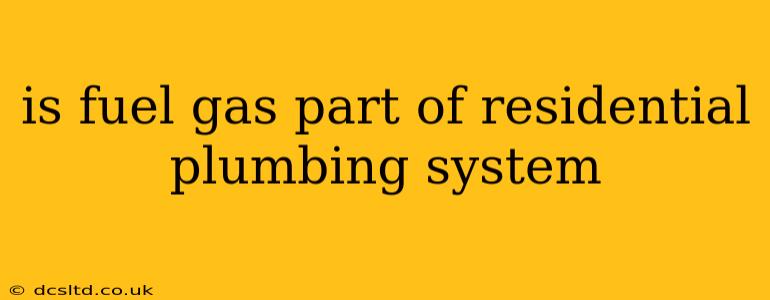The short answer is no, fuel gas is not part of the residential plumbing system. While both systems involve pipes and fittings within a home, they are completely separate and serve entirely different purposes. Plumbing systems handle water, while fuel gas systems deliver natural gas or propane for heating, cooking, and sometimes other appliances. Confusing the two can be extremely dangerous.
This article will delve deeper into the distinctions between these two crucial home systems, addressing common questions and concerns.
What is a Residential Plumbing System?
A residential plumbing system encompasses all the pipes, fixtures, and appliances involved in the distribution of potable (drinkable) water within a home. This includes:
- Water supply pipes: Bringing water from the main water line into the house.
- Water distribution pipes: Branching off to supply sinks, toilets, showers, and other fixtures.
- Drainage pipes: Removing wastewater and sewage from the house to the sewer system.
- Fixtures: Sinks, toilets, showers, bathtubs, etc.
- Appliances: Dishwashers, washing machines (connected to both hot and cold water supplies).
What is a Residential Fuel Gas System?
A residential fuel gas system is a separate network dedicated to delivering flammable gas (natural gas or propane) safely to appliances that use it as fuel. These appliances typically include:
- Furnaces: Heating the home.
- Water heaters: Heating domestic hot water.
- Stoves and ovens: Cooking appliances.
- Fireplaces: Some fireplaces use gas logs.
- Gas dryers: Clothes drying.
This system comprises its own set of pipes, typically made of stronger, more corrosion-resistant materials, and requires specific safety measures and regulations to prevent leaks and explosions.
What are the Key Differences Between Fuel Gas and Plumbing Systems?
The most crucial difference lies in the nature of the substance being transported:
- Plumbing: Carries potable water, which is generally non-flammable and non-toxic (though contamination is always a possibility).
- Fuel Gas: Transports flammable and potentially explosive gas, requiring rigorous safety protocols.
Other key differences include:
- Pipe materials: Plumbing pipes are often made of copper, PVC, or PEX, while fuel gas pipes are typically made of black iron, steel, or other materials designed to withstand high pressure and potential corrosion from the gas.
- Pipe fittings: Different types of fittings are used, with fuel gas systems employing specialized connectors designed for gas safety.
- Pressure: Fuel gas lines operate under higher pressure than water lines.
- Regulations and inspections: Fuel gas installations are subject to strict safety codes and inspections to prevent leaks and explosions. Plumbing inspections primarily focus on water tightness and sanitation.
- Color-coding: Gas lines are often visually identifiable by a distinctive yellow or orange color-coding on the pipes.
Why is it Dangerous to Confuse the Two Systems?
Mixing up fuel gas and plumbing systems can lead to catastrophic consequences. A gas leak into the plumbing system can cause an explosion or asphyxiation. Conversely, water entering the gas system can cause corrosion, leaks, and malfunctions leading to dangerous gas build-up.
Who Installs and Maintains Fuel Gas Systems?
Fuel gas systems should only be installed and serviced by licensed and qualified gas fitters or plumbers who are experienced in handling natural gas or propane systems. Improper installation or maintenance can result in serious safety hazards.
How Can I Tell if I Have a Gas Leak?
A gas leak can be very dangerous and requires immediate action. Signs of a gas leak include the smell of rotten eggs (mercaptan, an odorant added to natural gas), hissing sounds from pipes, or a decrease in water heater or furnace efficiency. If you suspect a gas leak, leave your home immediately and contact your gas company or emergency services. Never attempt to repair a gas leak yourself.
In conclusion, while both fuel gas and plumbing systems are vital components of a home, they are distinctly separate and require specialized knowledge and expertise for installation and maintenance. Understanding their differences is crucial for ensuring the safety and well-being of your household.
